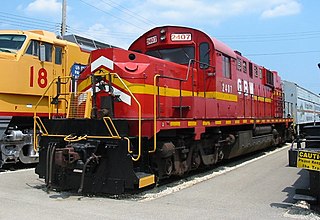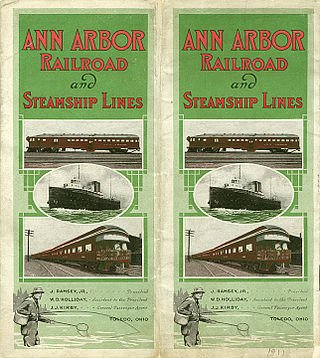
Elberta is a village in Benzie County in the U.S. state of Michigan. The population was 329 at the 2020 census. Located in Gilmore Township, Elberta overlooks Lake Michigan and lies across Betsie Lake from Frankfort. Elberta is part of Northern Michigan.
The Pere Marquette Railway was a railroad that operated in the Great Lakes region of the United States and southern parts of Ontario in Canada. It had trackage in the states of Michigan, Ohio, Indiana, and the Canadian province of Ontario. Its primary connections included Buffalo; Toledo; and Chicago. The company was named after Jacques Marquette, a French Jesuit missionary who founded Michigan's first European settlement, Sault Ste Marie.
The Detroit, Toledo and Ironton Railroad operated from 1905 to 1983 between its namesake cities of Detroit, Michigan, and Ironton, Ohio, via Toledo. At the end of 1970, it operated 478 miles of road on 762 miles of track; that year it carried 1,244 million ton-miles of revenue freight.

The Green Bay and Western Railroad served central Wisconsin for almost 100 years before it was absorbed into the Wisconsin Central in 1993. For much of its history the railroad was also known as the Green Bay Route. At the end of 1970 it operated 255 miles of road on 322 miles of track; that year it reported 317 million ton-miles of revenue freight.

The Grand Trunk Western Railroad Company was an American subsidiary of the Grand Trunk Railway, later of the Canadian National Railway operating in Michigan, Illinois, Indiana, and Ohio. Since a corporate restructuring in 1971, the railroad has been under CN's subsidiary holding company, the Grand Trunk Corporation. Grand Trunk Western's routes are part of CN's Michigan Division. Its primary mainline between Chicago and Port Huron, Michigan serves as a connection between railroad interchanges in Chicago and rail lines in eastern Canada and the Northeastern United States. The railroad's extensive trackage in Detroit and across southern Michigan has made it an essential link for the automotive industry as a hauler of parts and automobiles from manufacturing plants.

The Michigan Central Railroad was originally chartered in 1832 to establish rail service between Detroit, Michigan, and St. Joseph, Michigan. The railroad later operated in the states of Michigan, Indiana, and Illinois in the United States and the province of Ontario in Canada. After about 1867 the railroad was controlled by the New York Central Railroad, which later became part of Penn Central and then Conrail. After the 1998 Conrail breakup, Norfolk Southern Railway now owns much of the former Michigan Central trackage.

SS Milwaukee was a train ferry that served on Lake Michigan. It was launched in 1902 and sank with all hands off Milwaukee on October 22, 1929. Fifty-two men were lost with the vessel.

The Grand Trunk Milwaukee Car Ferry Company was the Grand Trunk Western Railroad's subsidiary company operating its Lake Michigan railroad car ferry operations between Muskegon, Michigan, and Milwaukee, Wisconsin, from 1905 to 1978. Major railroad companies in Michigan used rail ferry vessels to transport rail cars across Lake Michigan from Michigan's western shore to eastern Wisconsin to avoid rail traffic congestion in Chicago.

Durand Union Station is a historic train station in Durand, Michigan. The station, which now serves Amtrak Blue Water trains, was originally a busy Grand Trunk Western Railroad and Ann Arbor Railroad hub, as well as a local office for Grand Trunk Western, from its construction in 1903 until 1974. It is currently owned by the city of Durand and leased by Durand Union Station, Inc. a nonprofit organization dedicated to the preservation, restoration, and maintenance of the building and its surrounding property.

Martin Luther King Jr. Plaza is the main passenger rail and intercity bus station of Toledo, Ohio.

The Manistique and Lake Superior Railroad (M&LS) was an American Class III railroad serving the Upper Peninsula of Michigan from 1909 to 1968. It provided service from Manistique, Michigan to a junction with the Duluth, South Shore and Atlantic Railway at Doty, Michigan, southeast of Munising, Michigan. Its nickname was The Haywire.

SS City of Midland 41 was a train ferry serving the ports of Ludington, Michigan, Milwaukee, Wisconsin, Manitowoc, Wisconsin, and Kewaunee, Wisconsin, for the Pere Marquette Railway and its successor, the Chesapeake and Ohio Railway from 1941 until 1988. The ferry was named after the city of Midland, Michigan.

Railroads have been vital in the history of the population and trade of rough and finished goods in the state of Michigan. While some coastal settlements had previously existed, the population, commercial, and industrial growth of the state further bloomed with the establishment of the railroad.

The Ann Arbor Railroad is a Class III Railroad that operates fifty miles of track from Toledo, Ohio, to Osmer, Michigan. The railroad is operated by Watco and is based in Howell, Michigan. Prior to Watco's purchase of the railroad in 2013, the railroad was operated by the Ann Arbor Acquisition Corporation from 1988 to 2013.

SS Spartan is a railroad car ferry on Lake Michigan owned by the Chesapeake and Ohio Railway (C&O) from 1952 through 1979. It alternated routes from Ludington, Michigan, to Milwaukee, Kewaunee, and Manitowoc, Wisconsin.

The Wabash Railroad was a Class I railroad that operated in the mid-central United States. It served a large area, including track in the states of Ohio, Indiana, Illinois, Iowa, Michigan, and Missouri and the province of Ontario. Its primary connections included Chicago, Illinois; Kansas City, Missouri; Detroit, Michigan; Buffalo, New York; St. Louis, Missouri; and Toledo, Ohio.

Due to its unique geography, being made of two peninsulas surrounded by the Great Lakes, Michigan has depended on many ferries for connections to transport people, vehicles and trade. The most famous modern ferries are those which carry people and goods across the Straits of Mackinac to the car-free Mackinac Island but before the Mackinac Bridge was built, large numbers of ferries carried people and cars between the two peninsulas. Other ferries continue to provide transportation to small islands and across the Detroit River to Canada. Ferries once provided transport to island parks for city dwellers. The state's only national park, Isle Royale cannot be reached by road and is normally accessed by ferry. The largest ferries in Michigan are the car ferries which cross Lake Michigan to Wisconsin. One of these, the SS Badger is one of the last remaining coal steamers on the Great Lakes and serves as a section of US Highway 10 (US 10). The Badger is also the largest ferry in Michigan, capable of carrying 600 passengers and 180 autos.
The Michigan Interstate Railway was formed on August 27, 1977, to operate the Ann Arbor Railroad main line from Toledo, Ohio, to Elberta, Michigan. It succeeded Conrail as the designated operator of the line; Conrail had operated the line since 1976, following the Ann Arbor Railroad's bankruptcy.

The main line of Ann Arbor Railroad is a partially-abandoned railway line in the states of Michigan and Ohio. It was constructed between 1874 and 1897 by the Ann Arbor Railroad and its predecessors, and constituted that company's main line. At its fullest extent it ran 292 miles (470 km) from Toledo, Ohio, on Lake Erie, to Frankfort, Michigan, on Lake Michigan. A train ferry service operated across Lake Michigan to Wisconsin. The original Ann Arbor Railroad went bankrupt in 1976, and ownership of the line is now split between the state of Michigan and two short-line railroads: the Ann Arbor Railroad and the Huron and Eastern Railway. The northern end of the line is now near Yuma, Michigan.


















